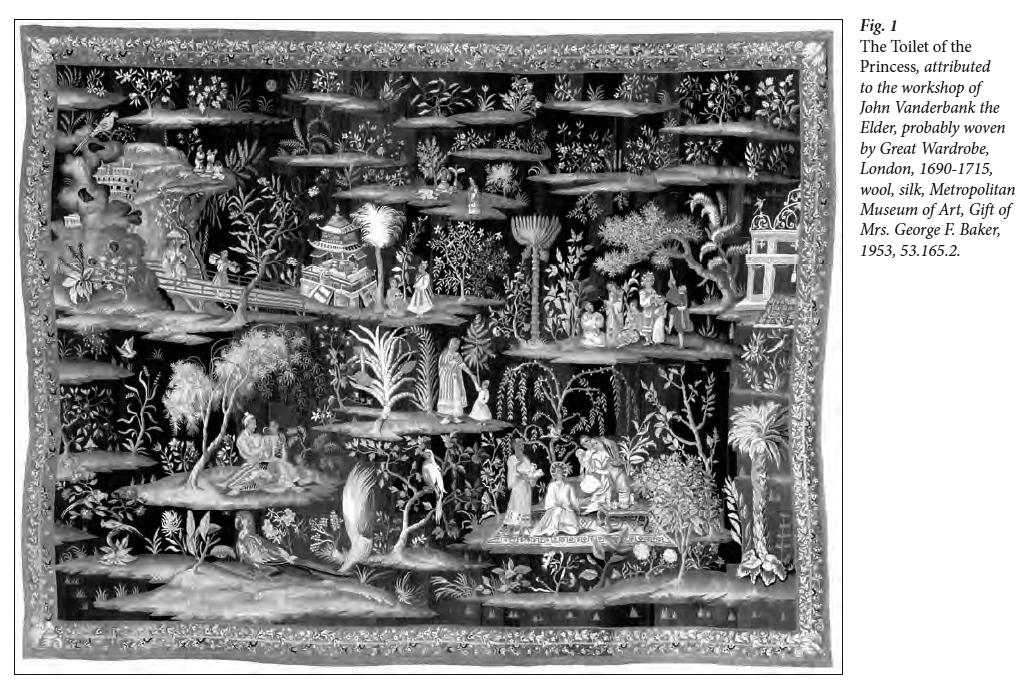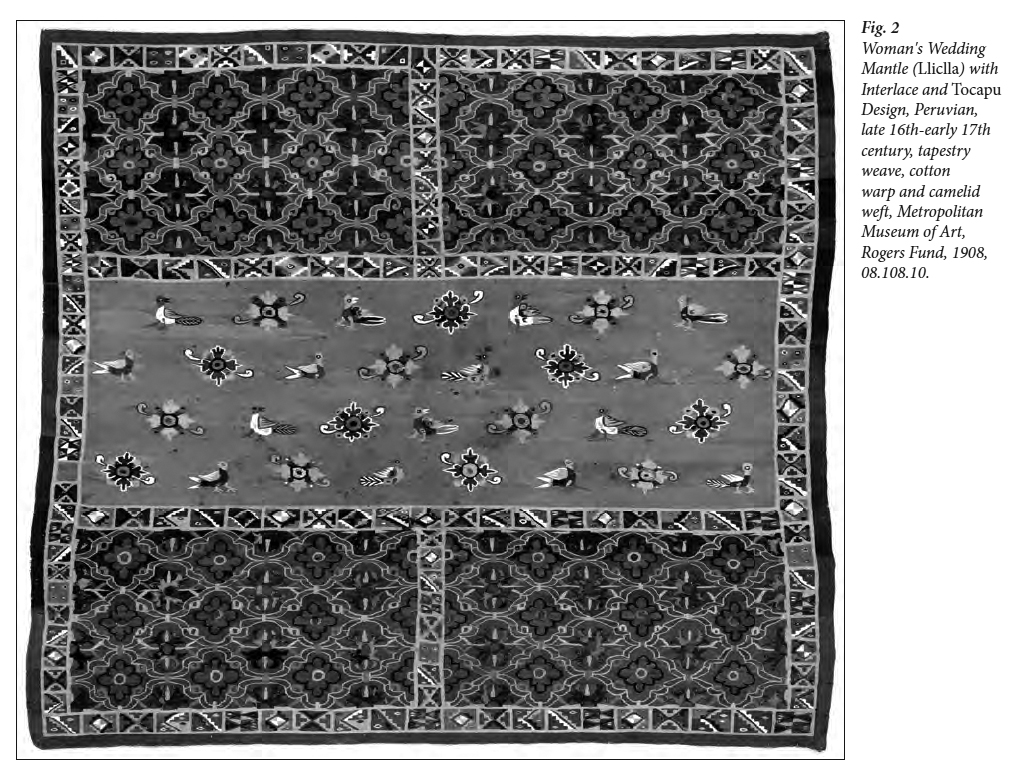Exhibition Review / Compte rendu d’exposition
Interwoven Globe: The Worldwide Textile Trade, 1500-1800
Interwoven Globe: The Worldwide Textile Trade, 1500-1800, The Metropolitan Museum of Art, September 16, 2013 to January 5, 2014
1 The Metropolitan Museum of Art’s spectacular fall show, Interwoven Globe, recounted a story of textiles from an economic and aesthetic perspective, emphasizing their role in trade and in the formulation of a new global design language in the early modern period.1 One major emblematic motif of the exhibition, for example, was the Tree of Life, commonly found on Indian palampores (painted and dyed cotton bedspreads or hangings for the export market). With examples of palampores peppered throughout the exhibition, the visitor could trace the migration and reinterpretation of this popular—and thus profitable—design, from China to England to India to America and back again. The result was a completely hybrid visual idiom that was practised around the world.
2 A persistent secondary thread of this story, however, is exoticism. Although this theme was overtly addressed in one gallery (“Looking East, Looking West”), it in fact pervaded the entire exhibition. Interwoven Globe provided rich material for the attentive viewer to explore the deployment of the “exotic”—that is, how foreign motifs, raw materials, and even stitching techniques were utilized as signifiers, usually of the owner’s worldliness, power, and wealth. More interesting, however, is how the exhibition uncovered the complex nature of exoticism. Although the exotic functioned unilaterally as a marker of difference, exoticism was not necessarily characterized by unidirectional exploitation of non-European by European. Exoticism, it turns out, is a much more ambivalent or flexible concept. Although these textiles reveal mostly how West consumed East, they also give us a glimpse of how non-Europeans perceived and interacted with Europeans.
3 The show opened with wall-size reproductions of 17th-century etchings of VOC (Dutch East Indies Company) ships. These images set the stage for the familiar narrative of European discovery and conquest of the Americas, Africa, and Asia in the 16th and 17th centuries. In other words, business-as-usual: we seemed to be situated within a Western perspective of history. Nevertheless, from the first gallery, and as one moved through the exhibition, objects were included that disrupted the standard account and reminded the visitor that a robust intra-Asian textile trade existed before the arrival of the Europeans, who were then incorporated into this extant trade network. For example, a sarasa, or Indian-painted and printed cotton for the Japanese market, is placed in the first gallery to demonstrate the transfer of a scrolling vine motif from England to India and then to Japan (cat. no. 13). One can surmise that this Anglo-Indian textile would have looked doubly exotic to its Japanese owner.
4 Similarly, a brilliant scarlet wool samurai surcoat (cat. no. 30), displayed in a later gallery, flaunts the owner’s wealth and status through his ability to obtain foreign goods. Japan was “closed” to the West during the early modern period, meaning that they only officially traded with the Dutch.2 European wool was thus a precious commodity, especially in a country that did not raise sheep. Furthermore, the eye-catching red dye was achieved with the help of a Mexican insect, cochineal. This exotic surcoat made from recognizably foreign materials must have conveyed an air of worldliness on its Japanese owner. Likewise, a Japanese-style morning gown exhibited nearby surely afforded its Dutch owner a comparable appearance of sophistication (cat. no. 96). The exhibition presents several other loose-fitting, Asian-inspired robes, called banyans, that European and American men wore to signal their intellectual gentility. There are even several portraits of merchants—John Singleton Copley’s Joseph Sherburne (ca. 1767) and Prince Demah Barnes’s William Duguid (1773)—who specifically chose to be depicted in this informal dress, not only to indicate their international connections, but also to fashion themselves as members of a literati elite.
5 English portraits of women in Turkish dress would seem to provide a direct complement to these male models of self-fashioning. Yet here is where the exotic reveals its double nature, where it crosses with the double standard of gender. Sir Joshua Reynolds’s portrait of Mrs. Horton and the Reynolds workshop portrait of Mrs. George Baldwin in turbaned headdresses and loose-fitting gowns were not necessarily straightforward declarations of their sophistication. The Ottoman practice of polygamy and keeping harems was an endless source of both titillating fascination and moral repugnance for Westerners. The unavoidable undertone of the Reynolds portraits is therefore the questionable respectability of these women, which of course was part of their allure. And yet the inclusion of Lady Mary Wortley Montagu’s letters, displayed nearby, hints at another way women could appropriate exotic dress. Lady Montagu, whose husband was the English ambassador to Turkey, was known to go out in Adrianople fully veiled as a way to both hide/escape her European identity and adopt a spectating position somewhat akin to the male flâneur (Pointon 1993: 152).
6 Desire and disdain form the psychological and emotional underpinnings of exoticism. Interwoven Globe presented various opportunities to reflect on this thorny duality. Chintz (painted and printed Indian cotton) made up a large part of the exhibition, owing to its popularity and importance as a trade textile. Chintz was so heavily imported in the 17th century that in 1700 England prohibited the use of the cloth in an attempt to protect and stimulate the domestic textile industry. This ban reveals not only the exotic fabric’s success as an international signifier of worldliness, but also its superiority as a product; the cheap, lightweight, colour-fast textile filled a need in the Western market, especially in England where the domestic specialty was wool. Desire for chintz was quickly followed by disgust as this exotic, Indian cloth was likened to a sort of infestation in English homes in the early 18th century. In 1708, Daniel Defoe wrote, “it crept into our houses, our closets and bedchambers; curtains, cushions, chairs, and at last beds themselves were nothing but Callicoes or Indian stuffs” (qtd. in Peck 2013: 88).
7 A fine line existed between exoticism and racism. The exotic, as mentioned earlier, served as a general marker of difference. Cultures and peoples from various countries could thus be clumped together under one overarching “exotic” umbrella. An English tapestry on view, Toilet of the Princess (1690-1715), is a case in point (Fig. 1). It presents an odd mixture of Chinese and Indian motifs and vignettes—a pagoda-like structure alongside a bearded figure in Indian dress, Chinese blue-and-white porcelains in one scene, an Indian mother with her head covered in a long scarf known as a dupatta in another, all against a dark background that is supposed to recall Chinese lacquer. The equating of one exotic culture with another demonstrates the blissful ignorance of geography and of the origins of various East India Company goods on the part of the Western public. Alternatively, the tapestry’s indiscriminate emulation of Eastern goods and motifs perhaps evidences a market incentive: combining Indian and Chinese images in one object upped the exotic “ante” of the product, allowing it to distinguish itself and compete with actual Indian and Chinese products on the market. In any case, the purpose of this object and others like it was not to learn about other cultures, but to spice up one’s own domestic surroundings.
 Display large image of Figure 1
Display large image of Figure 1
8 Toilet of the Princess, along with many other objects in the exhibition, is an example of the domestication of the exotic, of making the strange familiar or the familiar strange. The English tapestry is exoticized with Eastern colouration and motifs, which are in turn domesticated by their incorporation and interpretation in a Western format and technique. Exoticism, as Interwoven Globe shows us, depends on an oscillation or balance between these two poles of the familiar and the strange. We can further see this in a delicate Indian bedcover made for export in which a scrolling vine pattern derived from English embroidery is combined with Indian flora and fauna (cat. no. 11); thus, the Indian artists familiarized a foreign composition with domestic motifs while the English owner received an exoticized version of a familiar pattern. The domestication of the exotic is also evident in several bedspreads made in the West after Middle Eastern or Indian designs and motifs. A coverlet stitched for the marriage of Phebe Warner in New York, presumably by a female relative, transforms the Tree of Life motif from Indian palampores into a vase filled with domestic flowers.
9 As these textiles demonstrate, hybridity was often exoticism’s bedfellow. This relationship is best exemplified by the textiles created in New Spain. A fine Incan wedding mantle (Fig. 2, cat. no. 17) is decorated with Spanish interlace patterns and tocapu, or geometric designs indicative of Incan rank. This garment, woven probably for the marriage of an Incan noblewoman to a Spanish colonial administrator, is evidence of the mixed race (mestizo) society that was forming in South and Central America in the early modern period. With politically motivated intermarriages, cross-cultural dress quickly became the new norm. In this case, the domestication of the exotic meant transforming the foreign into family. Further interweaving the hybrid and the exotic is an Andean tapestry featuring scenes from the Old Testament, classical mythology, Peruvian life, and a central roundel inspired by the Chinese phoenix-and-dragon motif (cat. no. 20). One of the greatest revelations of the show was the cultural exchange between New Spain and China via Spanish galleons from Manila in the Philippines. The astonishing Andean tapestry on display, which was probably owned by a mestizo scholar, is a consummate example of the global interchange and layering of cultural translations that the textile trade unleashed.
 Display large image of Figure 2
Display large image of Figure 2
10 The concept of hybridity is a useful way to think about the exoticism of Interwoven Globe’s textiles. Often the importation of exotic objects is associated with a process of decontextualization or semantic dispersion, and the sense of loss that accompanies the removal of a work from the culture that created it and gave it meaning. The hybrid trade textiles of the Metropolitan’s exhibition, however, circumvent this process and its emotional cast, perhaps inhabiting instead the realm of Homi K. Bhabha’s “third space” (1994). They represent the creation of a new design type that originated in neither one place nor another, but rather belonged to a third, hybrid space that produced its own, regenerative meaning. The exhibition’s “bizarre silks”—an unfortunate term inherited from mid-20th-century historians—were woven in China and serve as a salient example (cat. nos. 44b and 45). European bizarre silk originated as Western imitations of exotic (Chinese, Persian, Indian, and Ottoman) motifs. When these patterns were subsequently sent to China to be copied, they were further reinterpreted as strange, fantastical flora and architecture, so far removed from their original sources that they are almost unidentifiable as forms. In these silks, West and East each constructed the other as exotic. What was lost in translation was gained in a new global, visual language.